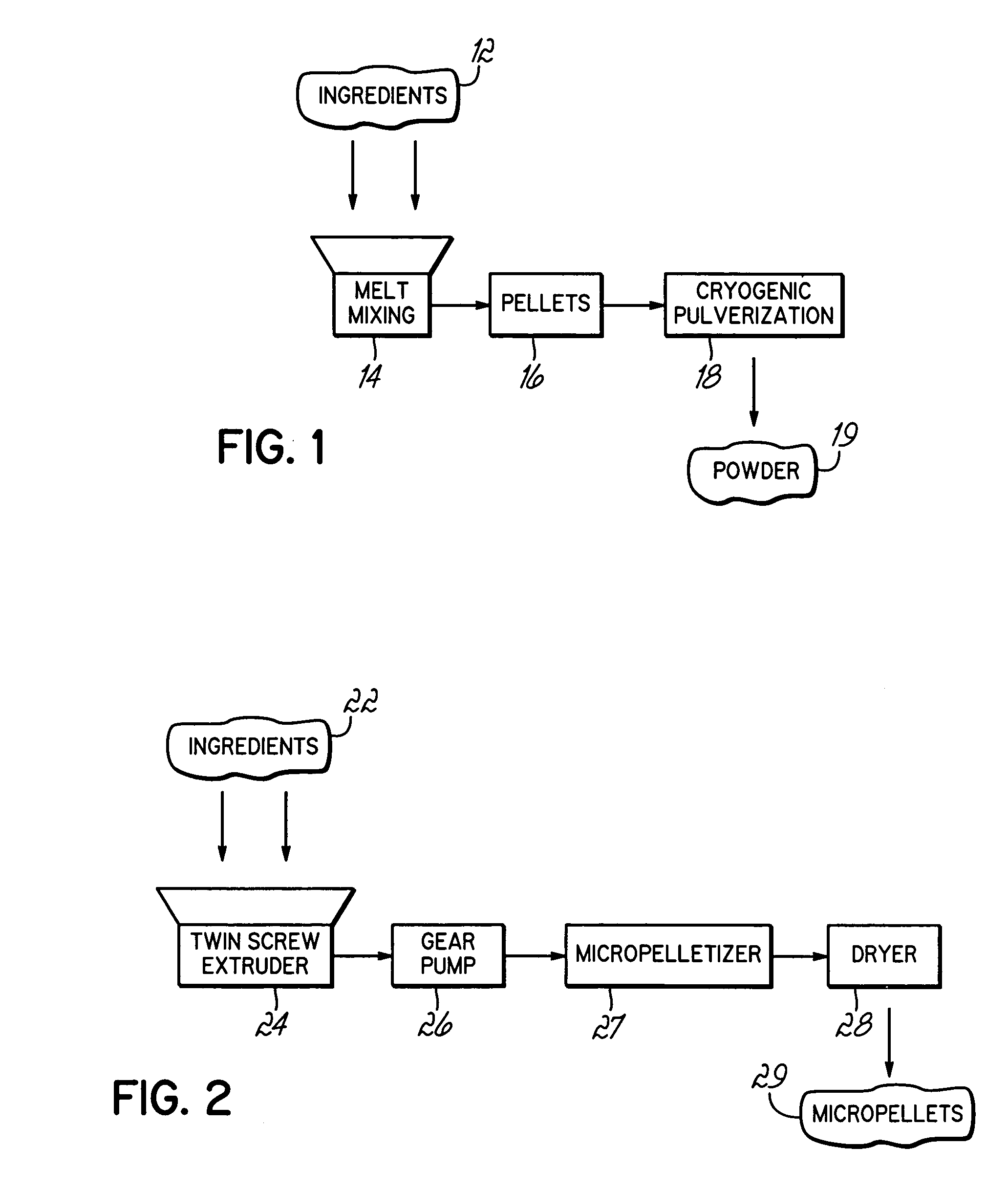Slush moldable thermoplastic polyolefin formulation for interior skin
a thermoplastic polyolefin and composition technology, applied in the direction of coatings, etc., can solve the problems of inability to achieve the desired material properties of a slush molding process, inability to alter the material, and inability to achieve the desired material properties, etc., to achieve the effect of improving the melt flow properties, reducing surface friction, and enhancing scratch resistan
- Summary
- Abstract
- Description
- Claims
- Application Information
AI Technical Summary
Benefits of technology
Problems solved by technology
Method used
Image
Examples
example 7
[0049] Composition G was prepared by melt mixing 14 using a twin-screw extruder and converted by cryogenic pulverization 18 into powder 19 using the scheme shown in FIG. 1. The composition of G, in wt. % of total composition, consists of the same components used in composition F, namely about 40 wt. % polypropylene polymer (45 g / 10 min MFI) and about 60 wt. % styrene copolymer elastomer. Composition G further contained 10 parts of process oil per 100 parts of resin.
[0050] Composition G had a measured zero shear viscosity of 405 Pa·s at 215° C., which is considered suitable for a slush molding composition. Thus, the viscosity of the composition can be significantly altered by the addition of the process oil in accordance with the present invention. In addition, composition G had a lower glass transition temperature of −34° C.
example 9
[0053] Composition I was prepared by melt mixing 14 using a twin-screw extruder and converted by cryogenic pulverization 18 into powder 19 using the scheme shown in FIG. 1. The composition of I, in wt. % of total composition, consists of about 30 wt. % polypropylene polymer, about 30 wt. % LLDPE, and about 40 wt. % styrene copolymer elastomer. Specifically, the same components used in composition H were used for composition I, but with 30% of the styrene elastomer replaced by the 30% LLDPE.
[0054] Composition I had a measured zero shear viscosity of 750 Pa·s at 215° C., which is considered suitable for a slush molding composition. Thus, the viscosity of the composition can be significantly altered by substituting part of one or both of the styrene elastomer polypropylene with LLDPE.
example 10
[0055] Composition J was prepared by melt mixing 14 using a twin-screw extruder and converted by cryogenic pulverization 18 into powder 19 using the scheme shown in FIG. 1. The composition of J, in wt. % of total composition, consists of about 30 wt. % polypropylene polymer, about 50 wt. % styrene copolymer elastomer, and about 20 wt. % LLDPE. Composition J further contained 7.5 parts of process oil per 100 parts of resin.
[0056] Composition J had a measured zero shear viscosity of 550 Pa·s at 215° C., which is considered suitable for a slush molding composition. In addition, composition J had a glass transition temperature of −33° C., which is considered suitable for automotive interior skin applications. The surface quality of a slush-molded skin made from Composition J was found to be good with minimal surface pinholes.
[0057] Using the Ford 5-Finger test for unpainted slush molded samples, with a 1 mm tip and applied loads of 2-7N, the skin formed from composition J had a scratc...
PUM
| Property | Measurement | Unit |
|---|---|---|
| zero shear viscosity | aaaaa | aaaaa |
| wt. % | aaaaa | aaaaa |
| wt. % | aaaaa | aaaaa |
Abstract
Description
Claims
Application Information
 Login to View More
Login to View More - R&D
- Intellectual Property
- Life Sciences
- Materials
- Tech Scout
- Unparalleled Data Quality
- Higher Quality Content
- 60% Fewer Hallucinations
Browse by: Latest US Patents, China's latest patents, Technical Efficacy Thesaurus, Application Domain, Technology Topic, Popular Technical Reports.
© 2025 PatSnap. All rights reserved.Legal|Privacy policy|Modern Slavery Act Transparency Statement|Sitemap|About US| Contact US: help@patsnap.com

